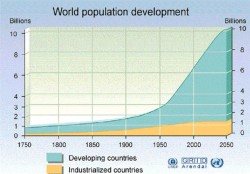

The TV footage of the typhoon destruction and the narrative brings up examples of women who lost 5, 6, 7 children. By 2010 it has exploded to 94 million and projected to grow to 150 million. The Philippine population was 7.9 million in 1900. Weisman discusses the Philippines intransigence to population control and the involvement of the Catholic Church as a bulwark of opposition. The combination of a (perhaps) climate change induced superstorm in the Philippines and the population of that island nation is a case in point.

If people don’t do something about population nature will intervene. Countdown makes the case that humans may be about as intelligent as algae in a pond about to suffocate themselves with overpopulation. Neither the article nor she proposed doing something about population. The article and the student proposed solutions that were all predicated on the premise that food production had to be increased to feed the increasing human population. Recently in a class I teach a student summed up an article that concluded climate change could lead to a 2% decline in food production each decade of the 21st century. PLEASE NOTE: When you purchase this title, the accompanying reference material will be available in your My Library section along with the audio. Weisman visits an extraordinary range of the world's cultures, religions, nationalities, tribes, and political systems to learn what in their beliefs, histories, liturgies, or current circumstances might suggest that sometimes it's in their own best interest to limit their growth. For this long awaited follow-up book, Weisman traveled to more than 20 countries to ask what experts agreed were probably the most important questions on Earth - and also the hardest: How many humans can the planet hold without capsizing? How robust must the Earth's ecosystem be to assure our continued existence? Can we know which other species are essential to our survival? And, how might we actually arrive at a stable, optimum population, and design an economy to allow genuine prosperity without endless growth? Behind that groundbreaking thought experiment was his hope that we would be inspired to find a way to add humans back to this vision of a restored, healthy planet - only in harmony, not mortal combat, with the rest of nature.īut with a million more of us every four days on a planet that's not getting any bigger, and with our exhaust overheating the atmosphere and altering the chemistry of the oceans, prospects for a sustainable human future seem ever more in doubt. In his best-selling book The World Without Us, Alan Weisman considered how the Earth could heal and even refill empty niches if relieved of humanity's constant pressures. A powerful investigation into the chances for humanity's future from the author of the best seller The World Without Us.


 0 kommentar(er)
0 kommentar(er)
